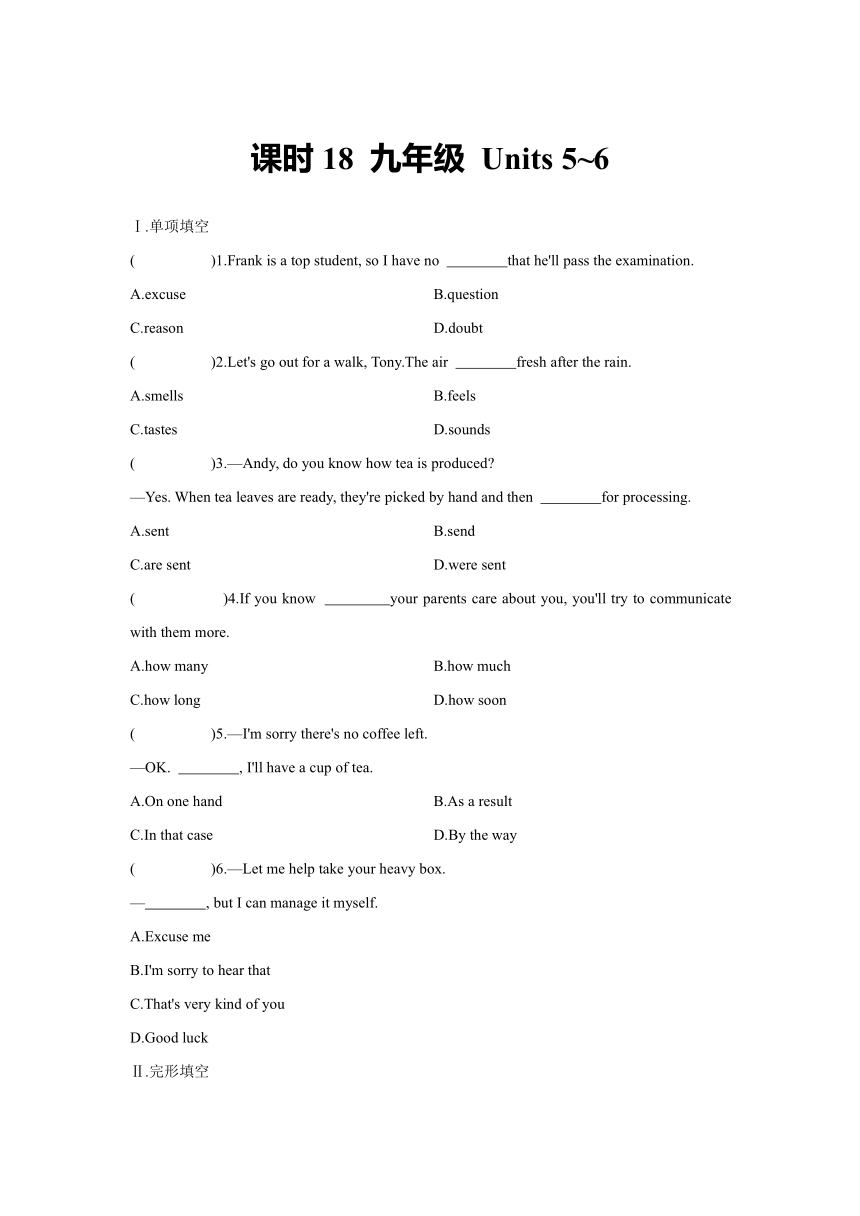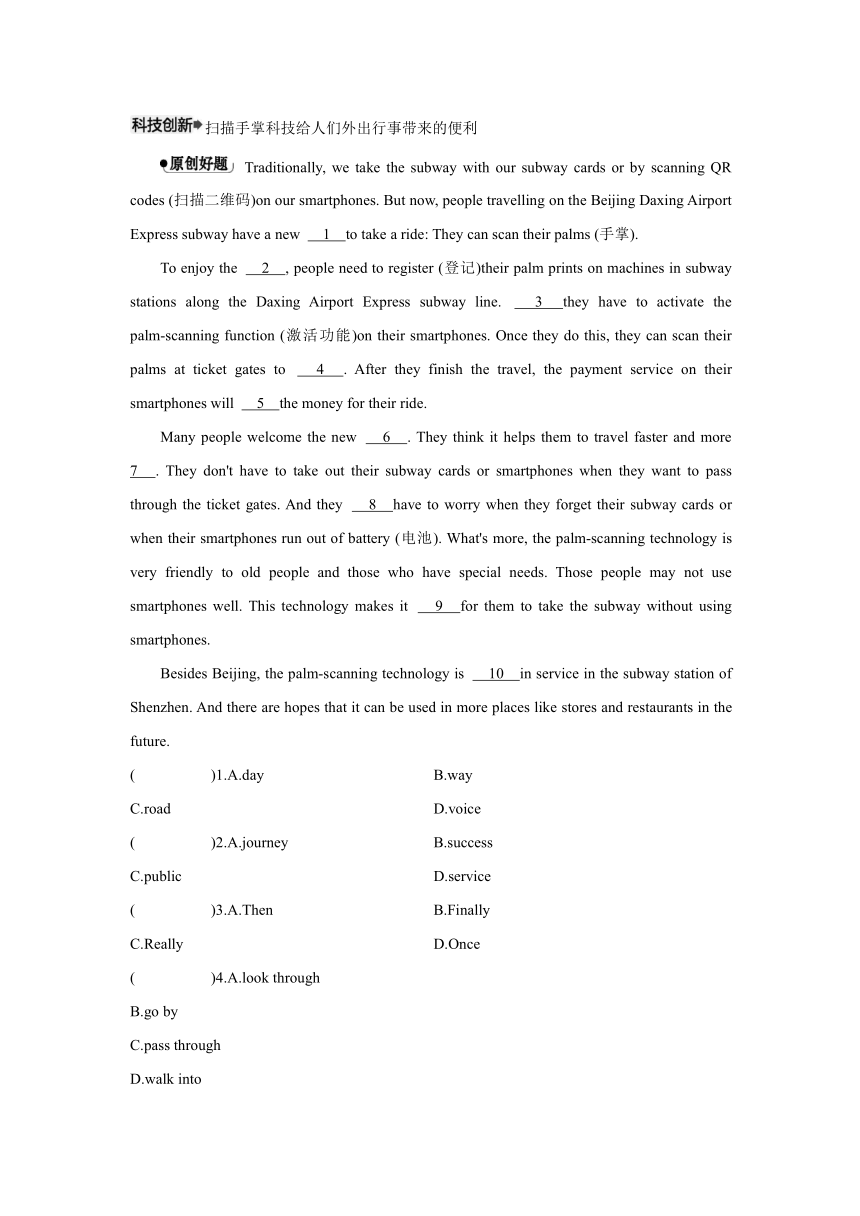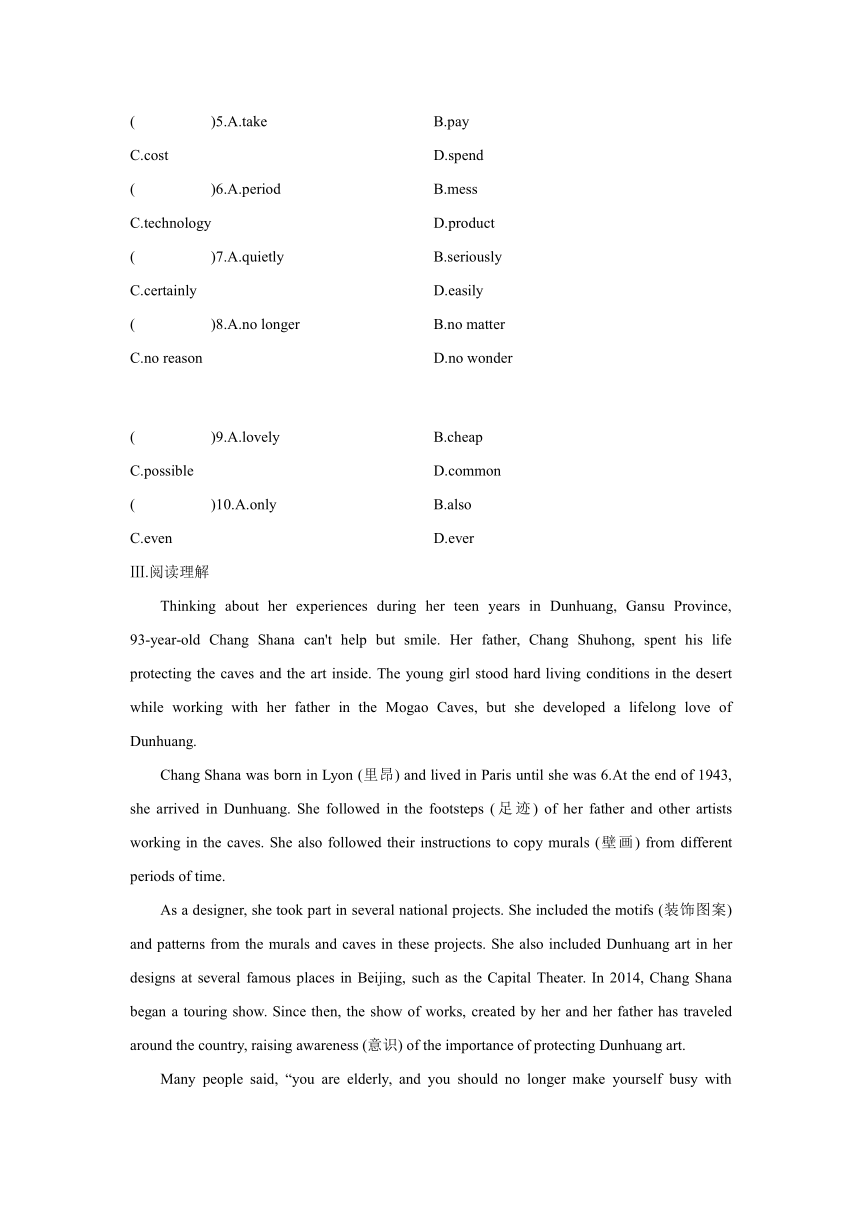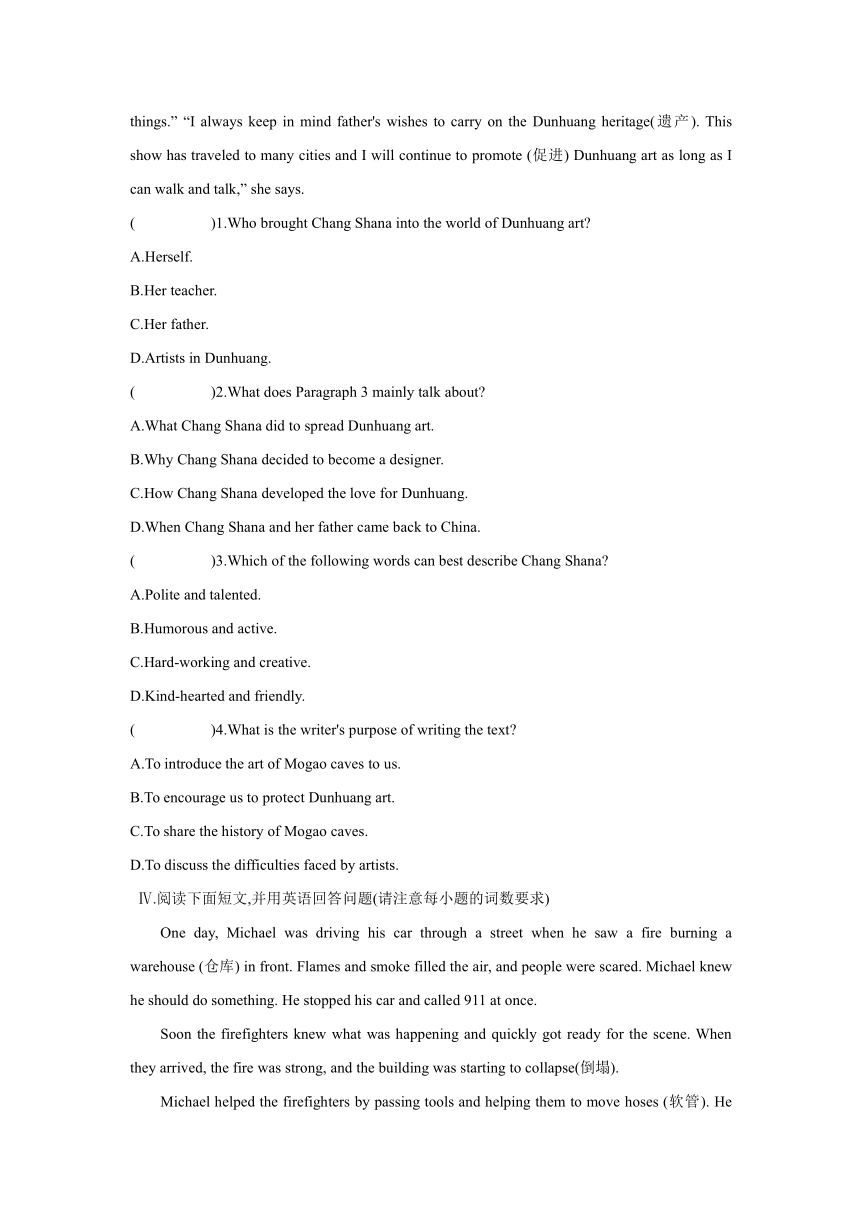课时18 九年级 Units 5~6 2025年中考英语(人教版)一轮复习基础练(含解析)
文档属性
| 名称 | 课时18 九年级 Units 5~6 2025年中考英语(人教版)一轮复习基础练(含解析) |  | |
| 格式 | docx | ||
| 文件大小 | 30.3KB | ||
| 资源类型 | 教案 | ||
| 版本资源 | 人教新目标(Go for it)版 | ||
| 科目 | 英语 | ||
| 更新时间 | 2024-10-31 18:22:06 | ||
图片预览




文档简介
课时18 九年级 Units 5~6
Ⅰ.单项填空
( )1.Frank is a top student, so I have no that he'll pass the examination.
A.excuse B.question
C.reason D.doubt
( )2.Let's go out for a walk, Tony.The air fresh after the rain.
A.smells B.feels
C.tastes D.sounds
( )3.—Andy, do you know how tea is produced
—Yes. When tea leaves are ready, they're picked by hand and then for processing.
A.sent B.send
C.are sent D.were sent
( )4.If you know your parents care about you, you'll try to communicate with them more.
A.how many B.how much
C.how long D.how soon
( )5.—I'm sorry there's no coffee left.
—OK. , I'll have a cup of tea.
A.On one hand B.As a result
C.In that case D.By the way
( )6.—Let me help take your heavy box.
— , but I can manage it myself.
A.Excuse me
B.I'm sorry to hear that
C.That's very kind of you
D.Good luck
Ⅱ.完形填空
扫描手掌科技给人们外出行事带来的便利
Traditionally, we take the subway with our subway cards or by scanning QR codes (扫描二维码)on our smartphones. But now, people travelling on the Beijing Daxing Airport Express subway have a new 1 to take a ride: They can scan their palms (手掌).
To enjoy the 2 , people need to register (登记)their palm prints on machines in subway stations along the Daxing Airport Express subway line. 3 they have to activate the palm-scanning function (激活功能)on their smartphones. Once they do this, they can scan their palms at ticket gates to 4 . After they finish the travel, the payment service on their smartphones will 5 the money for their ride.
Many people welcome the new 6 . They think it helps them to travel faster and more 7 . They don't have to take out their subway cards or smartphones when they want to pass through the ticket gates. And they 8 have to worry when they forget their subway cards or when their smartphones run out of battery (电池). What's more, the palm-scanning technology is very friendly to old people and those who have special needs. Those people may not use smartphones well. This technology makes it 9 for them to take the subway without using smartphones.
Besides Beijing, the palm-scanning technology is 10 in service in the subway station of Shenzhen. And there are hopes that it can be used in more places like stores and restaurants in the future.
( )1.A.day B.way
C.road D.voice
( )2.A.journey B.success
C.public D.service
( )3.A.Then B.Finally
C.Really D.Once
( )4.A.look through
B.go by
C.pass through
D.walk into
( )5.A.take B.pay
C.cost D.spend
( )6.A.period B.mess
C.technology D.product
( )7.A.quietly B.seriously
C.certainly D.easily
( )8.A.no longer B.no matter
C.no reason D.no wonder
( )9.A.lovely B.cheap
C.possible D.common
( )10.A.only B.also
C.even D.ever
Ⅲ.阅读理解
Thinking about her experiences during her teen years in Dunhuang, Gansu Province, 93-year-old Chang Shana can't help but smile. Her father, Chang Shuhong, spent his life protecting the caves and the art inside. The young girl stood hard living conditions in the desert while working with her father in the Mogao Caves, but she developed a lifelong love of Dunhuang.
Chang Shana was born in Lyon (里昂) and lived in Paris until she was 6.At the end of 1943, she arrived in Dunhuang. She followed in the footsteps (足迹) of her father and other artists working in the caves. She also followed their instructions to copy murals (壁画) from different periods of time.
As a designer, she took part in several national projects. She included the motifs (装饰图案) and patterns from the murals and caves in these projects. She also included Dunhuang art in her designs at several famous places in Beijing, such as the Capital Theater. In 2014, Chang Shana began a touring show. Since then, the show of works, created by her and her father has traveled around the country, raising awareness (意识) of the importance of protecting Dunhuang art.
Many people said, “you are elderly, and you should no longer make yourself busy with things.” “I always keep in mind father's wishes to carry on the Dunhuang heritage(遗产). This show has traveled to many cities and I will continue to promote (促进) Dunhuang art as long as I can walk and talk,” she says.
( )1.Who brought Chang Shana into the world of Dunhuang art
A.Herself.
B.Her teacher.
C.Her father.
D.Artists in Dunhuang.
( )2.What does Paragraph 3 mainly talk about
A.What Chang Shana did to spread Dunhuang art.
B.Why Chang Shana decided to become a designer.
C.How Chang Shana developed the love for Dunhuang.
D.When Chang Shana and her father came back to China.
( )3.Which of the following words can best describe Chang Shana
A.Polite and talented.
B.Humorous and active.
C.Hard-working and creative.
D.Kind-hearted and friendly.
( )4.What is the writer's purpose of writing the text
A.To introduce the art of Mogao caves to us.
B.To encourage us to protect Dunhuang art.
C.To share the history of Mogao caves.
D.To discuss the difficulties faced by artists.
Ⅳ.阅读下面短文,并用英语回答问题(请注意每小题的词数要求)
One day, Michael was driving his car through a street when he saw a fire burning a warehouse (仓库) in front. Flames and smoke filled the air, and people were scared. Michael knew he should do something. He stopped his car and called 911 at once.
Soon the firefighters knew what was happening and quickly got ready for the scene. When they arrived, the fire was strong, and the building was starting to collapse(倒塌).
Michael helped the firefighters by passing tools and helping them to move hoses (软管). He also helped to evacuate (疏散) people from nearby buildings. After a long and difficult battle, the fire was finally put out. The warehouse was damaged, but thankfully, no one was hurt. Michael's quick action and brave spirit saved lives and property.
The firefighters were impressed with Michael's bravery and teamwork. He became a hero to the town's people, too. They were grateful for his help.
Michael's actions taught them that anyone can be a hero if they are willing to help others.Helping others is a traditional virtue.
1.What did Michael see when he was driving his car through a street (不超过10个词)
2.How was the fire finally (不超过5个词)
3.What can we learn at the end of the text (不超过10个词)
Ⅴ.单词拼写
1.Let me h (加热) the food. It's getting cold already.
2.Lots of national h (英雄) appeared in Chinese history.
3.We should save every drop of water in our d (日常的) life.
4.She now helps in a l (当地的) school as a volunteer three days a week.
5.If you want to join the music club, fill in the f (表格) first.
Ⅵ.书面表达
假定你是李辉,你的新加坡笔友Peter近期要来你校参加主题为“中国传统文化”的研学活动,请你写一封邮件介绍你们学校的计划与安排。内容包括:
1.聆听诗词朗诵;
2.学习中国剪纸;
3.品尝传统美食;
4.……
注意:1.可适当增加细节,以使行文连贯;
2.文中不得出现真实姓名和地名;
3.词数80—100(邮件的开头和结尾已为你写好,不计入总词数)。
参考词汇:paper-cutting(n.剪纸)
Dear Peter,
I am happy to learn that you will come to my school. _________________
______________________________________________________________________________________________
______________________________________________________________________________________________
______________________________________________________________________________________________
______________________________________________________________________________________________
______________________________________________________________________________________________
______________________________________________________________________________________________
Best wishes!
Yours,
Li Hui
参考答案
Ⅰ.1~6 DACBCC
Ⅱ.1~5 BDACB 6~10 CDACB
【文章大意】 本文是一篇说明文,讲述的是扫描手掌科技的运用给人们的出行带来的便利。
1.B 考查名词辨析。句意:但现在,乘坐北京大兴机场线的人们有了一个新的地铁乘坐方式。day意为“天”;way意为“方法”;road意为“路”;voice意为“嗓音”。结合句意,故选B。
2.D 考查名词辨析。句意:为了享受这项服务,人们需要在大兴机场线沿线的地铁站的机器上注册他们的掌纹。journey意为“旅程”;success意为“成功”;public意为“平民”;service意为“服务”。结合句意,故选D。
3.A 考查副词辨析。句意:然后他们必须激活智能手机上的手掌扫描功能。then意为“然后”;finally意为“终于”;really意为“确实”;once意为“曾经”。结合句意,故选A。
4.C 考查短语动词辨析。句意:一旦他们这样做了,他们就可以在售票门扫描手掌来通过。look through 意为“浏览”;go by意为“时光流失”;pass through意为“经过”;walk into意为“走进”。结合句意,故选C。
5.B 考查动词辨析。句意:在他们完成旅行后,智能手机上的支付服务将支付他们的乘车费用。take意为“花费”,主语是it;pay意为“支付”,主语是人;cost意为“花费”,主语是物;spend意为“花费”,主语是人。结合句意,故选B。
6.C 考查名词辨析。句意:许多人欢迎这项新科技。period意为“阶段”;mess意为“脏乱”;technology意为“科技”;product意为“产品”。结合句意,故选C。
7.D 考查副词辨析。句意:他们认为这有助于他们更快、更轻松地旅行。quietly意为“安静地”;seriously意为“严肃地”;certainly意为“当然”;easily意为“容易地”。结合句意,故选D。
8.A 考查副词短语辨析。句意:他们不再担心忘记带地铁卡或智能手机电池耗尽。no longer意为“不再”;no matter意为“不管”;no reason意为“没有理由”;no wonder 意为“难怪”。结合句意,故选A。
9.C 考查形容词辨析。句意:这项技术使他们不用使用智能手机就可以坐地铁成为可能。lovely意为“可爱的”;cheap意为“便宜的”;possible意为“可能的”;common意为“普通的”。 结合句意,故选C。
10.B 考查副词辨析。句意:除了北京,手掌扫描技术也在深圳地铁站使用。only意为“仅”;also意为“也”;even意为“甚至”;ever意为“曾经”。结合句意,故选B。
Ⅲ.1~4 CACB
【文章大意】 本文是一篇记叙文。本文主要介绍了常沙娜回忆她和父亲常书鸿坚守敦煌、保护石窟和里面的艺术的故事,文中描写了她对弘扬敦煌艺术的坚定信念,并用毕生时间发扬敦煌艺术。
【答案与解析】
1.C 细节理解题。根据第一段中的“Her father, Chang Shuhong, spent his life protecting the caves and the art inside. The young girl stood hard living conditions in the desert while working with her father in the Mogao Caves”可知,她的父亲常书鸿将常沙娜带入了敦煌艺术的世界。
2.A 段落大意题。第三段主要讲述了常沙娜作为设计师,将敦煌艺术元素融入多个项目,并通过巡回展传播敦煌艺术的故事。
3.C 推理判断题。文中常沙娜跟随父亲在艰苦环境中工作,以及她在设计中融入敦煌艺术并积极推广敦煌艺术等事迹,体现了她的勤劳和创新。
4.B 写作目的题。作者写这篇文章是为了鼓励我们保护敦煌艺术,文中常沙娜为传承和推广敦煌艺术所做的努力也体现了这一目的。
Ⅳ.1.A fire was burning a warehouse in front.
2.It was put out.
3.Helping others is a traditional virtue.
【文章大意】 任何人都可以成为英雄,只要他们愿意挺身而出帮助他人。本文讲述的是Michael在看到仓库着火后,迅速采取行动,拨打911并协助消防员灭火和疏散附近建筑物中的人们。尽管仓库受损,但没有人受伤。Michael的勇敢和团队合作精神不仅赢得了消防员的赞赏,也使他成了镇上的英雄。文章强调了帮助他人这一传统美德的重要性,鼓励人们在紧急情况下勇敢地提供帮助。
Ⅴ.1.heat 2.heroes 3.daily 4.local 5.form
Ⅵ.书面表达
Dear Peter,
I am happy to learn that you will come to my school. First, you'll listen to poetry recitation.Through it, you can better understand the charm of Chinese culture and language.Then,you will learn Chinese paper-cutting.Through the activity,we can not only broaden our horizons but also build up our practical ability.Next,you can taste the traditional food, so that you can know China better.Finally, you'll watch some videos about traditional Chinese festivals.
Best wishes!
Yours,
Li Hui
Ⅰ.单项填空
( )1.Frank is a top student, so I have no that he'll pass the examination.
A.excuse B.question
C.reason D.doubt
( )2.Let's go out for a walk, Tony.The air fresh after the rain.
A.smells B.feels
C.tastes D.sounds
( )3.—Andy, do you know how tea is produced
—Yes. When tea leaves are ready, they're picked by hand and then for processing.
A.sent B.send
C.are sent D.were sent
( )4.If you know your parents care about you, you'll try to communicate with them more.
A.how many B.how much
C.how long D.how soon
( )5.—I'm sorry there's no coffee left.
—OK. , I'll have a cup of tea.
A.On one hand B.As a result
C.In that case D.By the way
( )6.—Let me help take your heavy box.
— , but I can manage it myself.
A.Excuse me
B.I'm sorry to hear that
C.That's very kind of you
D.Good luck
Ⅱ.完形填空
扫描手掌科技给人们外出行事带来的便利
Traditionally, we take the subway with our subway cards or by scanning QR codes (扫描二维码)on our smartphones. But now, people travelling on the Beijing Daxing Airport Express subway have a new 1 to take a ride: They can scan their palms (手掌).
To enjoy the 2 , people need to register (登记)their palm prints on machines in subway stations along the Daxing Airport Express subway line. 3 they have to activate the palm-scanning function (激活功能)on their smartphones. Once they do this, they can scan their palms at ticket gates to 4 . After they finish the travel, the payment service on their smartphones will 5 the money for their ride.
Many people welcome the new 6 . They think it helps them to travel faster and more 7 . They don't have to take out their subway cards or smartphones when they want to pass through the ticket gates. And they 8 have to worry when they forget their subway cards or when their smartphones run out of battery (电池). What's more, the palm-scanning technology is very friendly to old people and those who have special needs. Those people may not use smartphones well. This technology makes it 9 for them to take the subway without using smartphones.
Besides Beijing, the palm-scanning technology is 10 in service in the subway station of Shenzhen. And there are hopes that it can be used in more places like stores and restaurants in the future.
( )1.A.day B.way
C.road D.voice
( )2.A.journey B.success
C.public D.service
( )3.A.Then B.Finally
C.Really D.Once
( )4.A.look through
B.go by
C.pass through
D.walk into
( )5.A.take B.pay
C.cost D.spend
( )6.A.period B.mess
C.technology D.product
( )7.A.quietly B.seriously
C.certainly D.easily
( )8.A.no longer B.no matter
C.no reason D.no wonder
( )9.A.lovely B.cheap
C.possible D.common
( )10.A.only B.also
C.even D.ever
Ⅲ.阅读理解
Thinking about her experiences during her teen years in Dunhuang, Gansu Province, 93-year-old Chang Shana can't help but smile. Her father, Chang Shuhong, spent his life protecting the caves and the art inside. The young girl stood hard living conditions in the desert while working with her father in the Mogao Caves, but she developed a lifelong love of Dunhuang.
Chang Shana was born in Lyon (里昂) and lived in Paris until she was 6.At the end of 1943, she arrived in Dunhuang. She followed in the footsteps (足迹) of her father and other artists working in the caves. She also followed their instructions to copy murals (壁画) from different periods of time.
As a designer, she took part in several national projects. She included the motifs (装饰图案) and patterns from the murals and caves in these projects. She also included Dunhuang art in her designs at several famous places in Beijing, such as the Capital Theater. In 2014, Chang Shana began a touring show. Since then, the show of works, created by her and her father has traveled around the country, raising awareness (意识) of the importance of protecting Dunhuang art.
Many people said, “you are elderly, and you should no longer make yourself busy with things.” “I always keep in mind father's wishes to carry on the Dunhuang heritage(遗产). This show has traveled to many cities and I will continue to promote (促进) Dunhuang art as long as I can walk and talk,” she says.
( )1.Who brought Chang Shana into the world of Dunhuang art
A.Herself.
B.Her teacher.
C.Her father.
D.Artists in Dunhuang.
( )2.What does Paragraph 3 mainly talk about
A.What Chang Shana did to spread Dunhuang art.
B.Why Chang Shana decided to become a designer.
C.How Chang Shana developed the love for Dunhuang.
D.When Chang Shana and her father came back to China.
( )3.Which of the following words can best describe Chang Shana
A.Polite and talented.
B.Humorous and active.
C.Hard-working and creative.
D.Kind-hearted and friendly.
( )4.What is the writer's purpose of writing the text
A.To introduce the art of Mogao caves to us.
B.To encourage us to protect Dunhuang art.
C.To share the history of Mogao caves.
D.To discuss the difficulties faced by artists.
Ⅳ.阅读下面短文,并用英语回答问题(请注意每小题的词数要求)
One day, Michael was driving his car through a street when he saw a fire burning a warehouse (仓库) in front. Flames and smoke filled the air, and people were scared. Michael knew he should do something. He stopped his car and called 911 at once.
Soon the firefighters knew what was happening and quickly got ready for the scene. When they arrived, the fire was strong, and the building was starting to collapse(倒塌).
Michael helped the firefighters by passing tools and helping them to move hoses (软管). He also helped to evacuate (疏散) people from nearby buildings. After a long and difficult battle, the fire was finally put out. The warehouse was damaged, but thankfully, no one was hurt. Michael's quick action and brave spirit saved lives and property.
The firefighters were impressed with Michael's bravery and teamwork. He became a hero to the town's people, too. They were grateful for his help.
Michael's actions taught them that anyone can be a hero if they are willing to help others.Helping others is a traditional virtue.
1.What did Michael see when he was driving his car through a street (不超过10个词)
2.How was the fire finally (不超过5个词)
3.What can we learn at the end of the text (不超过10个词)
Ⅴ.单词拼写
1.Let me h (加热) the food. It's getting cold already.
2.Lots of national h (英雄) appeared in Chinese history.
3.We should save every drop of water in our d (日常的) life.
4.She now helps in a l (当地的) school as a volunteer three days a week.
5.If you want to join the music club, fill in the f (表格) first.
Ⅵ.书面表达
假定你是李辉,你的新加坡笔友Peter近期要来你校参加主题为“中国传统文化”的研学活动,请你写一封邮件介绍你们学校的计划与安排。内容包括:
1.聆听诗词朗诵;
2.学习中国剪纸;
3.品尝传统美食;
4.……
注意:1.可适当增加细节,以使行文连贯;
2.文中不得出现真实姓名和地名;
3.词数80—100(邮件的开头和结尾已为你写好,不计入总词数)。
参考词汇:paper-cutting(n.剪纸)
Dear Peter,
I am happy to learn that you will come to my school. _________________
______________________________________________________________________________________________
______________________________________________________________________________________________
______________________________________________________________________________________________
______________________________________________________________________________________________
______________________________________________________________________________________________
______________________________________________________________________________________________
Best wishes!
Yours,
Li Hui
参考答案
Ⅰ.1~6 DACBCC
Ⅱ.1~5 BDACB 6~10 CDACB
【文章大意】 本文是一篇说明文,讲述的是扫描手掌科技的运用给人们的出行带来的便利。
1.B 考查名词辨析。句意:但现在,乘坐北京大兴机场线的人们有了一个新的地铁乘坐方式。day意为“天”;way意为“方法”;road意为“路”;voice意为“嗓音”。结合句意,故选B。
2.D 考查名词辨析。句意:为了享受这项服务,人们需要在大兴机场线沿线的地铁站的机器上注册他们的掌纹。journey意为“旅程”;success意为“成功”;public意为“平民”;service意为“服务”。结合句意,故选D。
3.A 考查副词辨析。句意:然后他们必须激活智能手机上的手掌扫描功能。then意为“然后”;finally意为“终于”;really意为“确实”;once意为“曾经”。结合句意,故选A。
4.C 考查短语动词辨析。句意:一旦他们这样做了,他们就可以在售票门扫描手掌来通过。look through 意为“浏览”;go by意为“时光流失”;pass through意为“经过”;walk into意为“走进”。结合句意,故选C。
5.B 考查动词辨析。句意:在他们完成旅行后,智能手机上的支付服务将支付他们的乘车费用。take意为“花费”,主语是it;pay意为“支付”,主语是人;cost意为“花费”,主语是物;spend意为“花费”,主语是人。结合句意,故选B。
6.C 考查名词辨析。句意:许多人欢迎这项新科技。period意为“阶段”;mess意为“脏乱”;technology意为“科技”;product意为“产品”。结合句意,故选C。
7.D 考查副词辨析。句意:他们认为这有助于他们更快、更轻松地旅行。quietly意为“安静地”;seriously意为“严肃地”;certainly意为“当然”;easily意为“容易地”。结合句意,故选D。
8.A 考查副词短语辨析。句意:他们不再担心忘记带地铁卡或智能手机电池耗尽。no longer意为“不再”;no matter意为“不管”;no reason意为“没有理由”;no wonder 意为“难怪”。结合句意,故选A。
9.C 考查形容词辨析。句意:这项技术使他们不用使用智能手机就可以坐地铁成为可能。lovely意为“可爱的”;cheap意为“便宜的”;possible意为“可能的”;common意为“普通的”。 结合句意,故选C。
10.B 考查副词辨析。句意:除了北京,手掌扫描技术也在深圳地铁站使用。only意为“仅”;also意为“也”;even意为“甚至”;ever意为“曾经”。结合句意,故选B。
Ⅲ.1~4 CACB
【文章大意】 本文是一篇记叙文。本文主要介绍了常沙娜回忆她和父亲常书鸿坚守敦煌、保护石窟和里面的艺术的故事,文中描写了她对弘扬敦煌艺术的坚定信念,并用毕生时间发扬敦煌艺术。
【答案与解析】
1.C 细节理解题。根据第一段中的“Her father, Chang Shuhong, spent his life protecting the caves and the art inside. The young girl stood hard living conditions in the desert while working with her father in the Mogao Caves”可知,她的父亲常书鸿将常沙娜带入了敦煌艺术的世界。
2.A 段落大意题。第三段主要讲述了常沙娜作为设计师,将敦煌艺术元素融入多个项目,并通过巡回展传播敦煌艺术的故事。
3.C 推理判断题。文中常沙娜跟随父亲在艰苦环境中工作,以及她在设计中融入敦煌艺术并积极推广敦煌艺术等事迹,体现了她的勤劳和创新。
4.B 写作目的题。作者写这篇文章是为了鼓励我们保护敦煌艺术,文中常沙娜为传承和推广敦煌艺术所做的努力也体现了这一目的。
Ⅳ.1.A fire was burning a warehouse in front.
2.It was put out.
3.Helping others is a traditional virtue.
【文章大意】 任何人都可以成为英雄,只要他们愿意挺身而出帮助他人。本文讲述的是Michael在看到仓库着火后,迅速采取行动,拨打911并协助消防员灭火和疏散附近建筑物中的人们。尽管仓库受损,但没有人受伤。Michael的勇敢和团队合作精神不仅赢得了消防员的赞赏,也使他成了镇上的英雄。文章强调了帮助他人这一传统美德的重要性,鼓励人们在紧急情况下勇敢地提供帮助。
Ⅴ.1.heat 2.heroes 3.daily 4.local 5.form
Ⅵ.书面表达
Dear Peter,
I am happy to learn that you will come to my school. First, you'll listen to poetry recitation.Through it, you can better understand the charm of Chinese culture and language.Then,you will learn Chinese paper-cutting.Through the activity,we can not only broaden our horizons but also build up our practical ability.Next,you can taste the traditional food, so that you can know China better.Finally, you'll watch some videos about traditional Chinese festivals.
Best wishes!
Yours,
Li Hui
